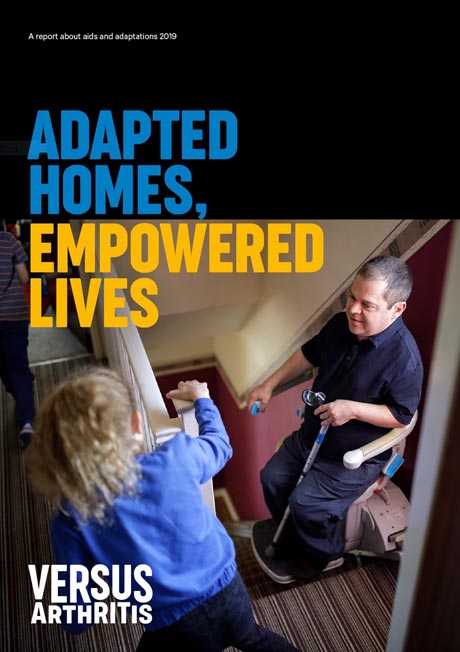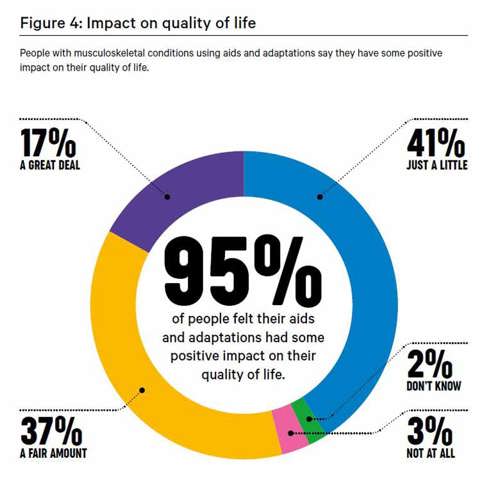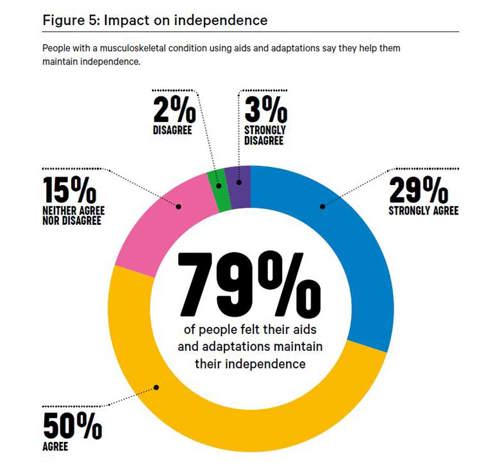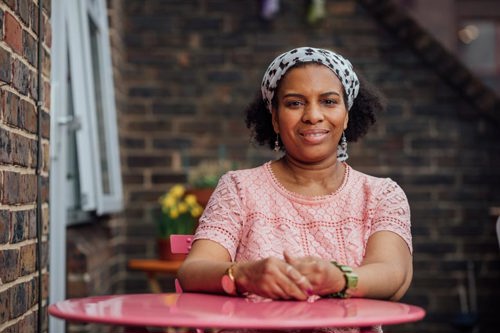Adapted homes, empowered lives: A report on home aids and adaptations

Versus Arthritis has found that home aids and adaptations can have a hugely positive impact on the quality of life of people with arthritis and can help them to maintain their independence. However, we have also discovered various barriers that make accessing these vital elements of support difficult. In this report, we set out our key findings and six recommendations for local and national government to improve the current system for providing aids and adaptations.
What are aids and adaptations?
An aid helps people to manage everyday tasks such as bathing, dressing, and cooking.
An adaptation is a more substantial addition or alteration that primarily helps someone to maintain freedom of movement around their home. Minor adaptations are defined as those costing less than £1000. Major adaptations cost more than £1000.
Community equipment is the name given to aids of any value and minor adaptations, costing less than £1000, in the Care Act 2014.
Key findings
We found that aids and adaptations positively impact on the lives of people with arthritis. In our study:
- 60% of all people with arthritis, across all genders, ages, and severity of condition, used an aid or adaptation
- Of those, 95% felt that these products had a positive impact on their lives
- 79% said they helped them maintain their independence.


However, we found barriers to accessing these products.
- Local authorities have a statutory duty to provide aids of any value and adaptations under the value of £1,000 to anybody with eligible care needs. However, we found that only 16% of people with arthritis with eligible care needs were aware of this duty.
- Furthermore, in our study 40% of people with a musculoskeletal condition have had difficulty acquiring aids and adaptations from their local authority.
This results in negative consequences for people with arthritis. In our study:
- 52% of people with arthritis with eligible care needs had purchased items themselves, despite being eligible for free support.
- 20% of people with eligible care needs did not use any aids or adaptations. This may indicate a level of unmet need.
What needs to happen
There is much scope to improve local authority provision of aids and adaptations to ensure people with musculoskeletal conditions get better access. To facilitate this, Versus Arthritis recommends:
- The Department of Health and Social Care (DHSC) should investigate and report on the reasons underlying the variation in local authority expenditure on community equipment.
- DHSC should commission an expert body to develop a centralised resource focused on home aids and adaptations. This should include updated best practice guidance for the provision of aids and adaptations, including information and advice, and evidence of return on investment.
- We recommend that the Government implements the recommendations from the 2018 independent, expert review of the Disabled Facilities Grant, particularly those focused on: future funding; information and advice for the general public; the means-test; and better analysis of local need.
- Local authorities should work with local partners to evaluate their information and advice services about aids and adaptations and housing, including the promotion of information and advice, in line with best practice guidance to ensure they meet the needs of people with musculoskeletal conditions.
- DHSC should ensure that the remit to NHS Digital for 2020-21 and subsequent years includes activity to deliver closer integration of data from social care, health care and community health settings. Such data should also be made available for research purposes.
- Building on the joint working by Department of Health and Social Care and Ministry of Housing, Communities and Local Government around the Social Care Green Paper, the Departments should establish ongoing ways of integrated working around social care and housing policy. An initial workstream should be the provision of home aids and adaptations.
Christine’s story
For people with arthritis, aids and adaptations can improve quality of life and empower people to live independently at home.
Here, Christine explains why aids and adaptations in her own home have improved her quality of live.

Jennylyn also explains that "After my diagnosis I found I needed a lot of help around the home and getting around in general. It can be a terrifying time being faced with the prospect of trying to do the things you’re struggling with, without help. It can leave you feeling so alone, and there’s no one telling you what help is available to you. The stress that comes with that can also have a knock-on effect on my rheumatoid arthritis, making my symptoms worse. Aids and adaptations have taken away the stress of everyday life, and I feel so much better. It has meant the difference between being able to cook healthy meals or not. The aids mean that my fatigue doesn’t get in the way and it’s opened up my word again. I’ve gone from being totally restricted to being able to lead a ‘normal’ life.”